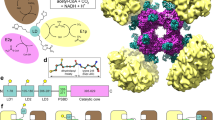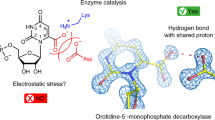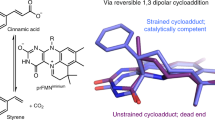Abstract
THE role of a coenzyme is studied mostly with respect to the mechanism of reactions catalysed by specific enzymes. It has been established in some cases that coenzymes and prosthetic groups have a protecting and stabilizing effect on the protein molecule. It is known that the large molecule of D-glyceralde-hyde-3-phosphate dehydrogenase (PGAD) (molecular weight 140,000) is labile, and does not contain disulphide linkages as stabilizing bonds1.
Similar content being viewed by others
Article PDF
References
Velick, S. F., in McElroy, W. D., and Glass, B., ed., “The Mechanism of Enzyme Action” 491 (Johns Hopkins Press, Baltimore 1954).
Velick, S. F., J. Biol. Chem., 233, 1455 (1958).
Elődi, P., and Szörényi, E., Acta Physiol. Hung., 9, 339 (1956).
Szabolcsi, G., Acta Physiol. Hung., 13, 214 (1958).
Author information
Authors and Affiliations
Rights and permissions
About this article
Cite this article
ELŐDI, P., SZABOLCSI, G. Role of the Coenzyme in the Stabilization of Glyceraldehyde-3-phosphate Dehydrogenase. Nature 184, 56 (1959). https://doi.org/10.1038/184056a0
Issue Date:
DOI: https://doi.org/10.1038/184056a0
This article is cited by
-
What’s in a name? From “fluctuation fit” to “conformational selection”: rediscovery of a concept
History and Philosophy of the Life Sciences (2021)
-
The effect of NADH and NAD+ on the proteolysis of lactate dehydrogenase isozymes by trypsin
Experientia (1971)
-
The mechanism of action of glyceraldehyde-3-phosphate dehydrogenase
Experientia (1964)
Comments
By submitting a comment you agree to abide by our Terms and Community Guidelines. If you find something abusive or that does not comply with our terms or guidelines please flag it as inappropriate.



